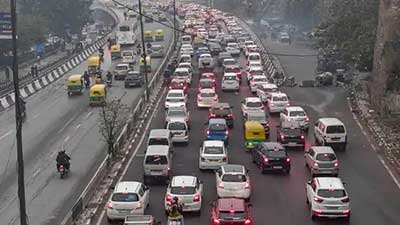Relevance: GS-3 : Awareness in the fields of IT, Space, Computers, Robotics,Nano technology, biotechnology and issues relating to intellectual property rights.
Key Phrases: FAME Scheme, Mobility as a Service, Urban Fossil-Fuel zones, Battery Swapping Policy, Recognition of Energy as Service, National Hydrogen Mission, vehicle electrification and hybridization, Swappable Battery Models.
Context:
- Over the last decade, the mobility sector has seen exponential growth.
- Since 1970, the growth of the global mobility industry has quadrupled, out-performing global gross domestic product growth.
- Today, the mobility sector is undergoing a rapid transformation driven by technology, digitization and sustainability.
What are The Innovations in The Automobile Industry for New Mobility Solutions ?
- Tranforming with changing consumer preferences, the industry is racing into a future of electric vehicles (EVs), connected cars, sensors and new business models like mobility-as-a-service.
- Non-service businesses are transforming vehicle build and design.
- New mobility solutions are a precursor to innovation in the automotive industry.
- Technological advances like ‘vehicular fog computing’ are bringing the reality of autonomous vehicles closer.
- The mobility space has been enriched with technologies for cyber security and the use of radars, lidars and simulation.
Technology Acting as A Catalyst of Automobile Industry Transformation :
- Latest trends in the auto industry are guided by technology.
- A move from conventional manufacturing to state-of-the-art design and manufacturing ecosystems is underway, with growing collaborations and emerging startups in the software space.
- There is a sharp rise in initiatives to transform the conventional internal combustion engine (ICE) auto industry into a technologically sophisticated one.
- One such initiative by component manufacturers to accelerate efforts on EVs and automation is the establishment of a Centre of Excellence at the IIT-Delhi campus in Sonipat, Haryana, while another one, with IIT-Bombay, is set to be announced shortly.
- These aim to give a fillip to industry-academia collaboration.
Addressing Consumer Related Challenges :
- Integrated mobility solutions have been emerging to address consumer challenges.
- Convenience is a key factor in today’s hyper-connected world, where easy-to-use, automated and digitized options are preferred.
- Anticipating market trends and exploring the consumer viability of business models require analysing consumer preferences with the help of telematics.
- These tracking tools help a business become more agile and also identify and scale new opportunities.
Shift Towards Sustainable Mobility :
- Global CO2 regulations have pushed the industry to be agile in adopting the latest innovations.
- There is a shift towards sustainable development to slow down climate change.
- To minimize dependence on fossil fuels and reduce pollution in metro
cities, the government has taken several measures :
- This Union budget emphasized creating Urban Fossil-Fuel zones, a Battery-Swapping policy and Recognition of Energy as Service.
- The government has extended the FAME -2 scheme for another three years and increased incentives for 2- and 3-wheeler batteries.
- There exist production-linked incentive (PLI) schemes for ACC battery storage units and auto products as well as auto components. As many as 20 automobile and 75 auto component makers have now got approvals under that scheme.
- Another landmark announcement was India’s policy on green hydrogen, which envisions India as a global leader in its production.
Milestones To be Achieved :
- Appropriate Charging Infrastructure :
- Many areas need to be worked upon for the expansion and integration of e-mobility.
- Range anxiety is one such point of contention for consumers who fear being stranded in case their EVs run out of charge.
- Industry and the government are working in tandem to increase charging stations in preparation of future demand.
- The focus is on creating the right standards for charging networks. The cost of chargers and their interoperability could be addressed by standardizing chargers. This will help lessen range anxiety.
- Cost of Batteries :
- The cost of batteries, which pushes up the total cost of EV ownership, is also being addressed.
- PLI schemes that support the localization of battery production, new battery chemistry and swappable battery models are expected to provide a major push.
- Increase in Investment :
- Investment in manufacturing by component players can be increased through demand aggregation for components.
- Non-essential items like motors and connectors can easily be aggregated.
- The scaling opportunity that can justify investments will be a major motivation.
- Original equipment and component makers will need to work closely in the EV space to develop products from an early stage.
- Startups and other new players will have to be co-opted and made integral to the design and manufacturing ecosystem.
- Paucity of semiconductors :
- The automobile sector is also going through a semiconductor shortage globally.
- Automobiles now have more electronic components, driven by smart connectivity features and re-engineered to meet tighter emission norms.
- With a move towards vehicle electrification and hybridization, we can expect more supply-side pressure, some of which could be eased by a robust semi-conductor making ecosystem.
Conclusion :
- Maintaining the trust of customers and living up to expectations will keep the wheels of this e-mobility revolution turning.
- Innovation, digital technology and sustainability will come together to generate top and bottom-line improvements.
- Advanced, autonomous and sustainable mobility is closer than many may think.
Source: Live Mint
Mains Question:
Q. Mobility sector is undergoing a rapid transformation driven by technology, digitization and sustainability. Discuss how technology is transforming the automobile industry worldwide. Also highlight various challenges faced by the industry. What are the important government initiatives taken by the government for sustainable growth of the industry ? (250 words ).








